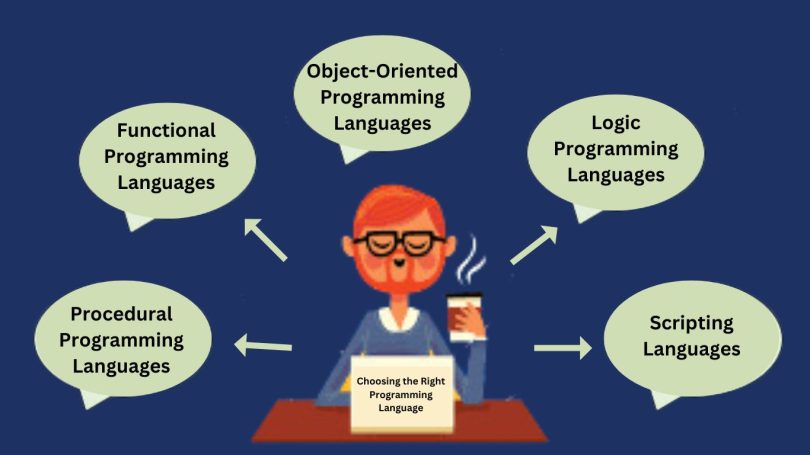Traditionally, programming is seen as an esoteric and exclusive domain of concern, limited to a few selected individuals with highly advanced “coding skills”. Nevertheless, modern times emphasize the irreplaceable nature of versatility in multiple programming languages, with wide applicability in numerous IT roles.
If people need to grow their careers or change their professional trajectories in the future, the possession of programming language expertise becomes a valuable asset. Since the investment of time and resources are the factors that are inherent in the language acquisition processes, the judicious choice of a programming language is the most important point.
Selecting the Right Programming Language for Growth:
The consideration of some factors is vital as people make this decision-making process; these include one’s tolerance for cognitive challenge, one’s existing programming abilities and one’s motives in pursuit of proficiency in a particular language. Whether the goal is the design of “mobile apps”, “earning programming certifications”, or the creation of new skill sets, the selection of the right programming language is the key to achieving this objective.
It is advised that people get accustomed to the current tendencies and the rapidly emerging needs for particular programming languages using which they can start a path of professional growth and upskilling that will fit the requirements of the current digital world.
The Main Types of Programming Languages:
- Procedural Programming Languages:
Procedural languages are characterized by the programming paradigm based on the usage of procedures and functions as units of code that can be used for defining and organizing the code into reusable modules. Distinguished cases of programming languages adopting this model include “C”, “Pascal”, and “FORTRAN”.
In procedural programming, a program is broken down into separate functions or procedures, which are treated as individualized sub-programs responsible for performing certain functions. These procedures are available for different parts of a program, which enables their flexibility and reusability. The paramount attention is given to the execution of the instructions in a systematic manner, which aims at the ordering operations that can operate the data stored within variables.
Procedural programming languages are applied extensively across several fields including “engineering”, “gaming” and “finance” as they help in implementing ordered programming methods. Despite the possible rigidity of the approach, procedural programming remains the cornerstone of the computer science courses and the sign of their importance is the fact that it is applied in the most prestigious academic programs.
- Functional Programming Languages:
Differing from procedural languages, functional programming languages provide higher flexibility through the employment of function as a primary construct. This model extends toward computational modeling and data transformation with “Haskell”, “Clojure”, “Lisp” and “Scala” being examples of these languages.
Functional programming provides the advantage of better reasoning and more reliability by limiting functions to operate solely on input and returning output only, without side effects or mutable state. For all the less widespread use cases in the industry, functional programming has recently gained popularity in the education context due to its didactic value in organizing programming paradigms and scalable software design.
Parallel processing which is the outstanding trait of functional programming is achieved with the aid of its statelessness and the support for nested functions. Utilizing the components of parallel execution, functional programming embraces consistent processing of concurrent operations and thus makes computers more efficient.
- Object-Oriented Programming Languages:
Object-oriented languages are characterized by the encapsulation of data and behavior within objects, which stand for the different entities of the system. Noticeable features are inherited, thus creating a hierarchy between classes with similar characteristics and encapsulated, allowing for hiding internal implementation details from external entities.
Exemplified by languages such as “Java”, “Python”, “C++” and “Ruby”, object-oriented programming allows developers to create very complex systems that are built up of interconnected objects.
- Scripting Languages:
Scripting languages encompass a wide group of languages sharing an identical execution model based on their being interpreted and a simplified syntax. Prominent examples of such languages are “server-side” and “client-side” scripting languages which enable passing of data between programming languages and execution environment.
Python is an indisputable scripting language that is used extensively, characterized by its inherent simplicity, concise high-level data structures and huge libraries for rapid application development.
Perl, praised for its dynamic features and text-manipulating abilities, is a common feature in popular websites like IMDB.
Bash, which is a scripting language commonly used in Linux/GNU systems, is user-friendly and enables the development of reusable scripts, thus, leading to high productivity and documentation.
- Logic Programming Languages:
Logic programming is the process of programming a computer using formal logic concepts as a foundation. Programs in this language are composed as collections of logical statements or rules that define relationships among the entities that make it possible to generate new information.
Being mostly utilized in domains such as artificial intelligence and expert systems, logic programming gives priority to reasoning and deduction, providing a clear and concise programming paradigm that is favorable to maintenance and understanding. The most salient feature of logical programming is a secure, flexible and adaptable approach to problem solving encompassing a variety of applications.
Prolog is perhaps the most well-known logical programming language, distinguished by the fact that it uses facts and rules to describe problems and solve reasoning tasks.
Imperative Programming:
In imperative programming, programmers provide the computer with a series of instructions specifying the sequence of steps to be taken and the manipulation of data structures and program states. As opposed to the functional programming paradigms that work with mathematical functions, imperative programming distinguishes procedural steps for program execution.
Languages like C, C++, Java and Python belong to the class of imperative programming languages and are used as basic tools in software development for tasks like system programming, low-level hardware control and even artificial intelligence.
Alternative Classification of Programming Languages:
- Front-end vs. Back-end Languages:
Front-end or client-side languages are applied to design visually appealing and interactive elements within websites, therefore, user interaction is enabled.
These are the major front-end languages which comprise of “HTML”, “CSS” and “JavaScript”.
However, as opposed to front-end, or client-side, languages which focus on the user interface, back-end, or server-side, languages are intended to achieve the logic and functionalities behind the scenes, including data processing and user authentication. The notable back-end languages include “Python”, “Ruby” and “Java”.
- High-level vs. Low-level Languages:
In addition to their readability and abstraction, high-level languages allow developers to write code which resembles natural language constructs. “Python”, “Java” and “Ruby” are examples of high-level languages, that have the prebuilt libraries and frameworks to facilitate the complex issues.
At the same time, low-level languages, e.g., “Assembly language” and “C”, allow for more control over hardware resources and memory management, but this comes at the cost of higher complexity and more manual work in coding.
- Interpreted vs. Compiled Languages:
Interpreted languages are executed line by line until the encoder produces machine code; thus the programs are executed immediately. For example: “Python”, “Ruby” and “JavaScript”.
Contrarily, the other kinds of languages, that is, the compiled ones, get translated into machine code before running which leads to better execution but necessitates its separate compilation step.
Compiled languages like C, C++, and Java are the command of the compiled paradigm that is useful in gaining speedy execution and optimization.
Conclusion:
Knowing how to program a computer is a useful skill to learn and can make you more professional. This article addressed the main types of programming languages, which have been done with the clear goal of explaining their distinct traits and functionalities. By getting to know what factors affect this decision, your learning targets and personal preferences, you can select the language to get the maximum benefit and to achieve your career objectives. Keep in mind that the environment of programming languages is one in which continuous change exists. Updating yourself with the emerging trends, as well as unlocking the doors to various sectors by learning different languages, can bring you to avenues of possibilities that are beckoning you. This article is a stepping stone towards programming language de-mystification and a step towards having the key skills you need to be digitally fit.








